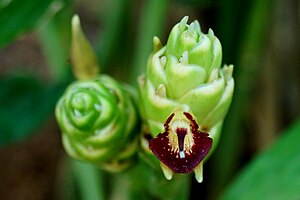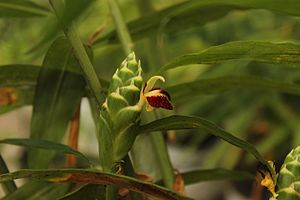Ginger/ja: Difference between revisions
Created page with "ショウガは、約5,000BPから始まったオーストロネシア人の拡散の航海において、カヌー植物として彼らと共に運ばれた。彼らは他の文明との接触よりもはるか以前の有史以前に、ショウガを太平洋諸島に導入した。マレー・ポリネシア祖語の「''*{{lang|mis|laqia}}'..." Tags: Mobile edit Mobile web edit |
Created page with "==ギャラリー== <gallery> File:Ginger Plant vs.jpg|ショウガの植物と花 File:Opening ginger flower.jpg|開花寸前のショウガの花 File:Ginger flower stamen.jpg|ショウガの花の雄しべ File:Ginger crop.jpg|ショウガ畑、ミャンマー File:Ginger on Dark Board.jpg|刻んだショウガ File:Gari ginger.jpg|ガリ(ショウガの漬物の一種) File:German Ginger wine with stem ginger decoration 4.jpg|ドイツのシ..." |
||
| (43 intermediate revisions by the same user not shown) | |||
| Line 32: | Line 32: | ||
ショウガは、約5,000[[:en:Before Present|BP]]から始まった[[:en:Austronesian expansion|オーストロネシア人の拡散]]の航海において、[[canoe plant/ja|カヌー植物]]として彼らと共に運ばれた。彼らは他の文明との接触よりもはるか以前の有史以前に、ショウガを[[:en:Pacific Island|太平洋諸島]]に導入した。[[:en:Proto-Malayo-Polynesian|マレー・ポリネシア祖語]]の「''*{{lang|mis|laqia}}''」の[[:en:reflex (linguistics)|反映形]]は、[[:en:Hawaii|ハワイ]]に至るまでのオーストロネシア語族の言語に見られる。彼らはまた、約3,500[[:en:Before Present|BP]]にオーストロネシアの船乗りが[[:en:Sri Lanka|スリランカ]]や[[:en:South India|南インド]]の[[:en:Dravidian languages|ドラヴィダ語]]を話す人々と初期接触した際に、他の東南アジアの食用植物や[[:en:Outrigger canoe|オーストロネシアの航海技術]]と共に、インドにも導入したと推定されている。紀元1千年紀には、オーストロネシアの航海者によって[[:en:Madagascar|マダガスカル]]や[[:en:Comoros|コモロ]]にも運ばれた。 | ショウガは、約5,000[[:en:Before Present|BP]]から始まった[[:en:Austronesian expansion|オーストロネシア人の拡散]]の航海において、[[canoe plant/ja|カヌー植物]]として彼らと共に運ばれた。彼らは他の文明との接触よりもはるか以前の有史以前に、ショウガを[[:en:Pacific Island|太平洋諸島]]に導入した。[[:en:Proto-Malayo-Polynesian|マレー・ポリネシア祖語]]の「''*{{lang|mis|laqia}}''」の[[:en:reflex (linguistics)|反映形]]は、[[:en:Hawaii|ハワイ]]に至るまでのオーストロネシア語族の言語に見られる。彼らはまた、約3,500[[:en:Before Present|BP]]にオーストロネシアの船乗りが[[:en:Sri Lanka|スリランカ]]や[[:en:South India|南インド]]の[[:en:Dravidian languages|ドラヴィダ語]]を話す人々と初期接触した際に、他の東南アジアの食用植物や[[:en:Outrigger canoe|オーストロネシアの航海技術]]と共に、インドにも導入したと推定されている。紀元1千年紀には、オーストロネシアの航海者によって[[:en:Madagascar|マダガスカル]]や[[:en:Comoros|コモロ]]にも運ばれた。 | ||
インドからは、紀元1世紀頃までに商人によって[[:en:Middle East|中東]]や[[:en:Mediterranean|地中海]]へと運ばれた。[[:en:spice trade|香辛料貿易]]の期間中、[[Piper (genus)/ja|コショウ]]、[[clove/ja|クローブ]]、その他多数の香辛料と共に、主に[[:en:southern India|南インド]]や[[:en:Greater Sunda Islands|大スンダ列島]]で栽培された。 | |||
==歴史{{Anchor|History}}== | |||
== History == | ショウガに関する最初の文献記録は、中国の[[:en:Warring States period|戦国時代]](紀元前475年-紀元前221年)に[[:en:Disciples of Confucius|孔子の弟子たち]]によって書かれた『[[:en:Analects|論語]]』に見られる。そこには、[[:en:Confucius|孔子]]が毎食ショウガを食べていたと記されている。406年には、僧侶の[[:en:Faxian|法顕]]が、ショウガが鉢植えで栽培され、[[scurvy/ja|壊血病]]を防ぐために中国の船に積まれて運ばれたと記している。[[:en:Song dynasty|宋王朝]](960年-1279年)の時代には、ショウガは南方諸国から中国に輸入されていた。 | ||
ショウガの香辛料はアラブ人によって地中海に伝えられ、[[:en:Dioscorides|ディオスコリデス]](40年-90年)や[[:en:Pliny the Elder|大プリニウス]](24年-79年)などの著述家によって記述された。150年には、[[:en:Ptolemy|プトレマイオス]]が[[:en:Ceylon|セイロン島]](スリランカ)でショウガが生産されていると記している。ショウガは、その近縁種である[[galangal/ja|ガランガル]]とともに、[[:en:Roman Empire|ローマ帝国]]に非常に高価な生薬の一部として輸入され、裕福な者だけが腎臓病などの治療に利用できた。[[:en:Aëtius of Amida|アエティウス・アミデンシス]]は、彼の複雑な生薬処方にショウガとガランガルの両方が含まれていることを記述している。[[:en:Middle Ages|中世]]になると、ヨーロッパ人の食の好みがショウガの料理特性に好意的に変化したため、生姜と保存されたショウガのヨーロッパへの輸入量が増加した。この間、ショウガはいくつかの国の公式な[[Pharmacopoeia/ja|薬局方]]に記載された。14世紀のイングランドでは、1ポンドのショウガは羊1頭と同じくらいの価格であった。 | |||
北西ヨーロッパにおけるショウガの考古学的証拠は、デンマーク・ノルウェーの旗艦「[[:en:Gribshunden|グリーブスフンデン]]」の難破船から見つかっている。この船は1495年の夏、ハンス王をスウェーデン評議会との首脳会談に運んでいる途中で、スウェーデン南部沖で沈没した。船に積まれていた贅沢品の中には、ショウガ、クローブ、サフラン、コショウが含まれていた。 | |||
ショウガの植物は、16世紀のいつか、スペイン王室の奨励により[[black pepper/ja|黒胡椒]]、[[cloves/ja|クローブ]]、[[cinnamon/ja|シナモン]]と共に、アジアからカリブ海の島々に密かに持ち込まれたが、ショウガだけが繁栄した。世紀末には、[[:en:Hispaniola|イスパニョーラ島]]と[[:en:Puerto Rico|プエルトリコ]]の両方で砂糖に取って代わり、主要な輸出品作物となった。しかし、17世紀にアフリカからの奴隷労働が導入されると、砂糖の生産がより経済的になり、ショウガの地位は低下した。 | |||
< | <span id="Horticulture"></span> | ||
== | ===栽培=== | ||
ショウガは白とピンクの[[flower bud/ja|花のつぼみ]]の[[Inflorescence/ja|房]]をつけ、それが開花すると黄色の花になる。その美的魅力と温暖な気候への植物の適応性から、[[:en:subtropical|亜熱帯]]の家庭の[[:en:landscaping|造園]]によく用いられる。これは、高さ約1メートル(3〜4フィート)の年間を通して葉のある茎を持つ[[perennial/ja|多年生]]の[[Reed bed/ja|アシ]]のような植物である。伝統的に、根茎は茎が[[wikt:wither|枯れた]]ときに収穫される。収穫後すぐに[[wikt:Special:Search/scald|湯通し]]するか、洗って皮を剥がすことで、根茎の活動を止め、[[sprouting/ja|発芽]]を防ぐ。ショウガ科植物の香り高い[[perisperm/ja|周乳]]は、[[:en:Bantu peoples|バンツー族]]によって[[sweetmeat/ja|砂糖菓子]]として、また薬味や[[sialogogue/ja|唾液分泌促進剤]]として利用される。 | |||
==生産{{Anchor|Production}}== | |||
==Production== | |||
{| class="wikitable" style="float:right; width:12em; text-align:center;" | {| class="wikitable" style="float:right; width:12em; text-align:center;" | ||
|+ | |+ 生ショウガの生産<br>{{small|2023, トン}} | ||
|- | |- | ||
| {{IND}} || 2,201,000 | | {{IND}} || 2,201,000 | ||
| Line 78: | Line 64: | ||
| {{THA}} || 174,103 | | {{THA}} || 174,103 | ||
|- | |- | ||
|''' | |'''世界''' || '''4,877,179''' | ||
|- | |- | ||
|colspan=2|{{small| | |colspan=2|{{small|情報源: [[United Nations|国連]]の[[Wikipedia:FAOSTAT|FAOSTAT]]}} | ||
|} | |} | ||
2023年における生姜の世界生産量は490万[[:en:tonne|トン]]であり、インドが全体の45%を占めて首位、[[:en:Nigeria|ナイジェリア]]と中国がそれに続く生産国であった。 | |||
=== インドでの生産 === | |||
=== | ショウガは世界中の多くの地域で栽培されているが、「南西インドで栽培され輸出された最も初期のスパイスの一つ」である。インドはショウガの輸出において世界第7位であるが、「世界最大のショウガ生産国」である。インド南西部および北東部の地域は、温暖で湿潤な気候、平均的な降水量、および広大な土地があるため、ショウガ生産に最も適している。 | ||
ショウガは多様な種類の土地や地域で生育可能であるが、標高{{convert|300|and|900|m|ft|abbr=on|-2}}の温暖で湿潤な環境で、深さ30 cm以上の水はけの良い土壌で栽培された場合に最もよく生産される。 | |||
インドで生産されるショウガは、ほとんどの場合、自給自足農法によって栽培されており、利用可能な家族や地域住民によって作業が柔軟に分担されている。 | |||
==ショウガ栽培{{Anchor|Ginger farming}}== | |||
== Ginger farming == | [[File:gingerfield.jpg|thumb|ショウガ畑]] | ||
[[File:gingerfield.jpg|thumb| | |||
ショウガの根茎の大きさは、ショウガ生産において不可欠である。根茎の断片が大きいほど、ショウガの生産が速くなり、その結果、市場への出荷も速くなる。種根茎を植える前に、農家は病害虫、根茎腐敗病、その他の[[:en:seed-borne disease|種子伝染性疾患]]を防ぐために種子を処理する必要がある。インドの農家が種子処理を行う様々な方法には、牛糞乳液に種子を浸す、貯蔵前に種子を燻煙する、温水処理などがある。 | |||
種子が適切に処理されたら、植え付ける農地を農家が徹底的に掘り起こすか、耕して土壌をほぐす必要がある。土壌が十分に耕された後(少なくとも3〜5回)、作物を灌漑するために{{convert|60–80|ft}}間隔で水路が作られる。 | |||
次の段階は、根茎の種子を植えることである。インドでは、灌漑されたショウガ作物の植え付けは通常、モンスーン、つまり雨季の始まりにあたる3月から6月の間に行われる。植え付け段階が終わると、農家は水分を保持し、雑草の生育を抑制するため、また土壌を保全するために表面流出を抑制するために、作物をマルチングする。マルチングは、植え付け直後と、生育後45日目、90日目に直接植物の畝にマルチ(例えば緑の葉)を施すことによって行われる。マルチングの後には畝立てが行われる。これは、雑草の生育を抑制し、雨による土壌の固まりをほぐし、土壌水分を保持するために土壌をかき混ぜてほぐす作業である。農家は、地域で降雨量が少ない場合、ショウガ作物に補足的な灌漑が行われていることを確認しなければならない。インドでは、最大収量と高品質の製品を確保するために、農家は9月から11月(モンスーンが終わった後)の間に少なくとも2週間に一度、ショウガ作物に灌漑を行う必要がある。 | |||
ショウガの最終的な栽培段階は収穫段階である。野菜、ソーダ、キャンディーなどの製品のために根茎が植えられた場合、収穫は植え付け後4〜5ヶ月の間に行われるべきである。一方、乾燥ショウガやショウガ油などの製品のために根茎が植えられた場合、収穫は植え付け後8〜10ヶ月に行われなければならない。 | |||
乾燥ショウガは、市販されているショウガの最も一般的な形態の一つである。乾燥ショウガ用の根茎は、完全に成熟した段階(8〜10ヶ月)で収穫される。水に浸した後、外皮は手作業で竹の破片や木のナイフで削り取られる。これは機械で行うにはあまりにも繊細な作業である。生ショウガは収穫後にさらなる加工は必要なく、より若い段階で収穫される。 | |||
==ショウガの輸送と輸出{{Anchor|Transportation and export of ginger}}== | |||
== Transportation and export of ginger == | ショウガは、国内または国際的な最終目的地へ輸送されるために様々な段階を経る。その道のりは、農家が生産物の一部を村の業者に販売するところから始まる。業者は農場の門で直接生産物を集荷する。集荷された生産物は最寄りの集荷市場に運ばれ、そこから主要な地域または地区レベルの販売センターへ運ばれる。大量の収穫がある農家は、直接地元の市場や地域の市場に生産物を持ち込む。生産物が「地域レベルの市場に到着すると、洗浄、等級分けされ、約60kgの袋に詰められる」。その後、ニューデリー、コーチ、ボンベイなどの最終市場へ輸送される。 | ||
ショウガが輸出される州は、インドの野菜流通経路に従っており、その手順は国内輸送の場合と類似している。ただし、地域転送センターの後に最終市場に到達する代わりに、生産物は輸出市場に到着し、その後、車両、飛行機、または船で最終的な国際目的地に送られ、現地の小売市場に到着し、購入されると最終的に消費者の手に渡る。 | |||
乾燥ショウガは、小規模な小売店のネットワークを含む独自の流通システムを通じて、アジア諸国間で最も盛んに取引されている。生姜と保存されたショウガは、しばしばスーパーマーケットチェーンに直接販売され、一部の国では、生姜は特定の民族コミュニティに特有の小さな店でしか見られない。インドは頻繁にショウガや他の野菜を近隣のパキスタンやバングラデシュ、また「サウジアラビア、アラブ首長国連邦、モロッコ、米国、イエメン共和国、英国、オランダ」に輸出している。 | |||
インドは世界最大のショウガ生産国であるにもかかわらず、主要な輸出国としての役割を果たしておらず、ショウガの総輸出量の約1.17%しか占めていない。インドにおけるショウガ栽培は費用がかかり、リスクの高い事業である。農家は輸出から多くの利益を得られず、「発生する総コストの65%以上が労働費と種子材料購入費に費やされている」。生産量の損失や価格の下落がなければ、農家は利益を得られる可能性があるが、これらを回避することは容易ではない。純粋な単一作物としてではなく、間作システムで栽培されたショウガや、乾燥ショウガの生産は、より高い費用対効果を示すことが分かっている。 | |||
==用途{{Anchor|Uses}}== | |||
==Uses== | ===料理=== | ||
=== | [[File:Ingwer 2 (fcm).jpg|thumb|right|フレッシュなショウガ根茎]] | ||
[[File:Ingwer 2 (fcm).jpg|thumb|right| | [[File:Fresh ginger.jpg|thumb|洗いたての生姜]] | ||
[[File:Fresh ginger.jpg|thumb| | |||
ショウガは、料理や民間療法として世界中で使われる一般的な香辛料である。ショウガは、野菜、キャンディー、ソーダ、漬物、アルコール飲料など、様々な食品に利用できる。 | |||
ショウガは香りの良い厨房用スパイスである。若いショウガの根茎はジューシーで肉厚で、マイルドな味がする。これらはしばしば[[vinegar/ja|酢]]や[[sherry/ja|シェリー]]に[[pickled/ja|漬けて]]軽食にしたり、多くの料理の具材として調理されたりする。沸騰したお湯に[[steeped/ja|浸して]]ショウガの[[herb tea/ja|ハーブティー]]にすることもでき、これには[[honey/ja|蜂蜜]]を加えてもよい。ショウガはキャンディーや[[ginger wine/ja|ジンジャーワイン]]に加工することもできる。 | |||
====アジア==== | |||
= | 成熟したショウガの根茎は[[fibrous/ja|繊維質]]で、ほとんど乾燥している。ショウガの根から出る汁は、[[Indian cuisine/ja|インド料理]]の味付けによく使われ、[[Chinese Cuisine/ja|中国料理]]、[[Korean cuisine/ja|韓国料理]]、[[Japanese Cuisine/ja|日本料理]]、[[Vietnamese cuisine/ja|ベトナム料理]]、および多くの南アジア料理で、[[seafood/ja|魚介類]]、[[meat/ja|肉類]]、[[vegetarian dishes/ja|ベジタリアン料理]]などの[[flavoring/ja|風味付け]]に一般的に使われる材料である。 | ||
[[File:Ginger in China 01.jpg|thumb|中国の2種類のショウガ]] | |||
[[File:Ginger in China 01.jpg|thumb| | |||
インド料理において、ショウガは特に濃厚なグレービーソースや、ベジタリアン料理、肉料理を問わず多くの他の料理の重要な材料である。ショウガは伝統的な[[Ayurvedic/ja|アーユルヴェーダ]]医学において役割を持つ。スパイスの効いた''[[masala chai/ja|マサラチャイ]]''を含む、伝統的なインドの冷たい飲み物と温かい飲み物の両方に使われる材料である。生のショウガは、[[pulse (legume)/ja|豆類]]や[[lentil/ja|レンズ豆]]のカレーやその他の野菜料理を作るのに使われる主要なスパイスの一つである。生のショウガと皮をむいたニンニクのクローブは、潰したりすりおろしたりして[[ginger garlic masala/ja|ジンジャーガーリックマサラ]]を作る。生姜だけでなく、乾燥したショウガも、特に冬に紅茶やコーヒーの風味付けに使われる。南インドでは、「サンバーラム」という夏のヨーグルトドリンクが、青唐辛子、塩、カレーリーフとともにショウガを主要な材料として作られる。ショウガの粉は、主に妊娠中または[[nursing/ja|授乳中]]の女性向けの食品に用いられ、最も一般的なものは、ガムレジン、''[[ghee/ja|ギー]]''、ナッツ、砂糖を混ぜた''カットルー''である。ショウガはまた、砂糖漬けやピクルスの形でも消費される。日本では、ショウガは漬物にして''[[beni shōga/ja|紅ショウガ]]''や''[[gari (ginger)/ja|ガリ]]''が作られたり、すりおろして[[tofu/ja|豆腐]]や[[noodle/ja|麺類]]に生のまま使われたりする。また、''ショウガの[[Sugar/ja|砂糖]][[Tsukemono/ja|漬け]]''と呼ばれる飴にもされる。伝統的な[[Korean cuisine/ja|韓国料理]]の''[[kimchi/ja|キムチ]]''では、ショウガは繊維質の食感を避けるため、細かく刻むか、またはジュースにして、発酵プロセスの直前に辛いペーストの材料に加えられる。 | |||
[[File:Steamed salted fish diced chicken rice 02.jpg|thumb|upright|ショウガのスライスが添えられた中華料理。一食あたりの一般的なショウガの摂取量を示している。]] | |||
[[File:Steamed salted fish diced chicken rice 02.jpg|thumb|upright| | [[:en:Myanmar|ミャンマー]]では、ショウガは「''gyin''」と呼ばれる。料理に広く使われるほか、[[traditional medicine/ja|伝統的な薬]]の主要な材料となっている。油漬けの細切りショウガに様々なナッツや種子を加えた「''gyin-thot''」と呼ばれる[[salad/ja|サラダ]]料理として食される。タイでは「ขิง ''khing''」と呼ばれ、料理にジンジャーガーリックペーストを作るのに使われる。[[:en:Indonesia|インドネシア]]では、ショウガと[[palm sugar/ja|パームシュガー]]から「''[[wedang jahe/ja|wedang jahe]]''」という飲み物が作られる。また、インドネシア人は「''jahe''」と呼ばれる粉砕したショウガの根を地元のレシピに共通の材料として使用する。[[:en:Malaysia|マレーシア]]では、ショウガは「''halia''」と呼ばれ、多くの種類の料理、特にスープに使われる。[[:en:Philippines|フィリピン]]では「''luya''」と呼ばれ、ショウガは地元の料理に共通の材料であり、「''salabat''」と呼ばれるお茶として淹れられる。[[:en:Vietnam|ベトナム]]では、生の葉を細かく刻んでエビとヤムイモのスープ(''canh khoai mỡ'')にトッピングとして加え、刻んだ根よりもはるかに繊細なショウガの風味を加えることができる。中国では、薄切りまたは丸ごとのショウガの根は魚などの風味豊かな料理と組み合わされることが多く、刻んだショウガの根は肉料理と組み合わされるのが一般的である。砂糖漬けのショウガは中国のキャンディボックスの構成要素となることがあり、ショウガから[[herbal tea/ja|ハーブティー]]を作ることもできる。生のショウガの汁は、牛乳を凝固させて[[dessert/ja|デザート]]の[[ginger milk curd/ja|ショウガ牛乳プリン]]を作るのに使うことができる。 | ||
====北米==== | |||
=== | [[:en:Caribbean|カリブ海]]諸国では、ショウガは料理の一般的なスパイスであり、[[sorrel (drink)/ja|ソレル]](クリスマスシーズンに作られる飲み物)などの飲み物を作るためにも使われる。[[Jamaican cuisine/ja|ジャマイカ人]]は、炭酸飲料としても家庭で新鮮なものとしてもジンジャービアを作る。ジンジャーティーは新鮮なショウガから作られることが多く、また有名な地域の特産品であるジャマイカジンジャーケーキもある。 | ||
====西洋諸国==== | |||
=== | [[File:Gingerbread landscape.jpg|thumb|[[:en:Gingerbread man|ジンジャーブレッドマン]]と妻、[[:en:gingerbread house|ジンジャーブレッドハウス]]]] | ||
[[File:Gingerbread landscape.jpg|thumb|[[Gingerbread man]] | |||
[[Western cuisine/ja|西洋料理]]では、ショウガは伝統的に主に[[ginger ale/ja|ジンジャーエール]]、[[gingerbread/ja|ジンジャーブレッド]]、[[ginger snap/ja|ジンジャースナップ]]、[[parkin (cake)/ja|パーキン]]、[[speculaas/ja|スペキュラース]]などの甘い食べ物に使われる。[[Jarnac/ja|ジャルナック]]、フランスで生産される[[Domaine de Canton (liqueur)/ja|カントン]]というショウガ風味の[[liqueur/ja|リキュール]]がある。[[Ginger wine/ja|ジンジャーワイン]]はイギリスで生産されるショウガ風味のワインで、伝統的に緑色のガラス瓶で販売されている。ショウガは熱いコーヒーや紅茶に加えるスパイスとしても使われる。ギリシャの[[:en:Corfu|ケルキラ島]]では、[[ginger beer/ja|ジンジャービア]]の一種であるトラディショナルドリンク τσιτσιμπύρα (''tsitsibira'') が作られている。ケルキラ島の人々と他の[[:en:Ionian Islands|イオニア諸島]]の人々は、[[:en:United States of the Ionian Islands|イオニア諸島合衆国]]時代にイギリス人からこの飲み物を取り入れた。 | |||
生のショウガは、粉末のショウガの6倍の比率で代用できるが、生のショウガと乾燥ショウガの風味は多少異なる。粉末状の乾燥ショウガの根は、通常、[[gingerbread/ja|ジンジャーブレッド]]、[[cookie/ja|クッキー]]、[[cracker (food)/ja|クラッカー]]、ケーキ、[[ginger ale/ja|ジンジャーエール]]、[[ginger beer/ja|ジンジャービア]]などのレシピの風味付けとして使われる。イギリスで「'''ステムジンジャー'''」として知られる砂糖漬けまたは[[crystallized ginger/ja|糖蜜漬けショウガ]]は、ショウガの根を柔らかくなるまで砂糖で煮たもので、[[confectionery/ja|菓子]]の一種である。生のショウガは食べる前に皮をむいてもよい。長期保存する場合は、ショウガをビニール袋に入れて冷蔵または冷凍する。 | |||
====中東==== | |||
==== | ショウガは[[Iranian cuisine/ja|イラン料理]]で使われる。ジンジャーブレッドは、[[:en:Gorgan|ゴルガン]]市で[[:en:Nowruz|ナウルーズ]](元日)の祝日に伝統的に作られるクッキーの一種である。 | ||
===類似する食材=== | |||
[[Zingiberaceae/ja|ショウガ科]]の他の植物も同様の方法で使われる。それらには、[[myoga/ja|ミョウガ]](''[[Zingiber mioga/ja|Zingiber mioga]]'')、数種類の[[galangal/ja|ガランガル]]、[[fingerroot/ja|フィンガー ルート]](''[[Boesenbergia rotunda/ja|Boesenbergia rotunda]]'')、[[bitter ginger/ja|ビタージンジャー]](''[[Zingiber zerumbet/ja|Zingiber zerumbet]]'')が含まれる。 | |||
北米東部原産の[[dicotyledon/ja|双子葉植物]]である''[[Asarum canadense/ja|Asarum canadense]]''も「[[Asarum/ja|ワイルドジンジャー]]」として知られ、その根は同様の芳香特性を持つが、真正ショウガとは関係がない。この植物には[[carcinogen/ja|発癌性]]化合物である[[aristolochic acid/ja|アリストロキア酸]]が含まれている。アメリカ食品医薬品局は、アリストロキア酸含有製品の摂取が「永久的な腎臓損傷、時には腎臓透析や腎臓移植が必要となる腎不全につながる」ことに関連していると警告している。さらに、一部の患者は特定の種類の癌、最も多くは尿路に発生する癌を発症している。 | |||
==栄養{{Anchor|Nutrition}}== | |||
==Nutrition== | {{Infobox nutritional value/ja | ||
{{Infobox nutritional value | | name = ショウガの根(生) | ||
| name = | |||
| image = Ginger cross section.jpg | | image = Ginger cross section.jpg | ||
| caption = | | caption = ショウガの根の断面 | ||
| kJ=333 | | kJ=333 | ||
| water=79 g | | water=79 g | ||
| Line 238: | Line 166: | ||
| vitE_mg=0.26 | | vitE_mg=0.26 | ||
| source_usda = 1 | | source_usda = 1 | ||
| note=[https://fdc.nal.usda.gov/fdc-app.html#/food-details/169231/nutrients | | note=[https://fdc.nal.usda.gov/fdc-app.html#/food-details/169231/nutrients USDAデータベースエントリへのフルリンク] | ||
}} | }} | ||
生のショウガには、79%の[[water/ja|水]]、18%の[[carbohydrates/ja|炭水化物]]、2%の[[protein (nutrient)/ja|タンパク質]]、1%の[[fat/ja|脂肪]]が含まれている(表)。100gあたりのすりおろしたショウガには、333kJ(80kcal)の[[food energy/ja|食物エネルギー]]が含まれており、[[potassium in biology/ja|カリウム]](一日摂取量、DVの14%)、[[magnesium in biology/ja|マグネシウム]](DVの10%)、[[manganese in biology/ja|マンガン]](DVの10%)が適度に含まれているが、その他の[[micronutrient/ja|微量栄養素]]の含有量は少ない(表)。 | |||
==組成と安全性{{Anchor|Composition and safety}}== | |||
==Composition and safety== | ショウガは適量であれば[[side effect/ja|副作用]]は少ないものの、大量に摂取すると[[gastrointestional/ja|胃腸]]の不調などの[[adverse event/ja|有害事象]]を引き起こしたり、[[prescription drug/ja|処方箋医薬品]]との好ましくない相互作用を引き起こしたりする可能性がある。[[FDA/ja|FDA]]の「[[:en:generally recognized as safe|GRAS]]」リストに掲載されているが、[[anticoagulant/ja|抗凝固薬]]である[[warfarin/ja|ワルファリン]]や[[心臓血管系|心血管]]薬である[[nifedipine/ja|ニフェジピン]]など、一部の医薬品とは[[cardiovascular/ja|相互作用]]がある。 | ||
===化学的性質=== | |||
=== | ショウガ特有の香りと風味は、新鮮なショウガの重量の1〜3%を占める[[volatility (chemistry)/ja|揮発性]]の[[:en:essential oil|精油]]に由来し、主に[[sesquiterpene/ja|セスキテルペン]]([[bisabolene/ja|β-ビサボレン]]や[[zingiberene/ja|ジンギベレン]]など)、[[zingerone/ja|ジンゲロン]]、[[shogaol/ja|ショウガオール]]、[[gingerol/ja|ジンゲロール]]で構成され、[6]-ジンゲロール(1-[4'-ヒドロキシ-3'-メトキシフェニル]-5-ヒドロキシ-3-デカノン)が主要な辛味成分である。生のショウガには約400種類の化合物が存在する。 | ||
ジンゲロンは乾燥中にジンゲロールから生成され、辛味は弱いが、スパイシーで甘い香りを持つ。ショウガオールはより辛味が強く、加熱、貯蔵、または酸性条件下でジンゲロールから生成される。この他に、多くの[[monoterpene/ja|モノテルペン]]、[[amino acid/ja|アミノ酸]]、[[dietary fiber/ja|食物繊維]]、タンパク質、[[phytosterol/ja|フィトステロール]]、[[vitamin/ja|ビタミン]]、[[dietary mineral/ja|ミネラル]]などが含まれる。生のショウガには、[[cysteine protease/ja|システインプロテアーゼ]]である酵素[[zingibain/ja|ジンジバイン]]も含まれており、[[rennet/ja|レンネット]]と同様の特性を持つ。 | |||
==研究{{Anchor|Research}}== | |||
==Research== | ショウガの使用が妊娠中の[[nausea/ja|吐き気]]軽減と関連するというエビデンスは、質が低い。ショウガが化学療法による吐き気や嘔吐の緩和に役立つという良好なエビデンスはない。 | ||
妊娠中の[[nausea/ja|吐き気]]を治療するためにショウガを摂取することが安全であるという明確なエビデンスはない。ショウガは[[dysmenorrhea/ja|月経困難症]]の治療には効果がない。[[anti-inflammatory/ja|抗炎症]]作用があるというエビデンスはいくつかあるが、[[osteoarthritis/ja|変形性関節症]]の痛みに影響するというエビデンスは不十分である。ショウガが[[platelet/ja|血小板]]凝集や[[Coagulation/ja|血液凝固]]に影響を与えるという良好なエビデンスはない。 | |||
2018年のレビューでは、ショウガが肥満被験者の体重を減少させ、[[HDL-cholesterol/ja|HDLコレステロール]]を増加させる可能性があるというエビデンスが見出された。 | |||
==有害作用{{Anchor|Adverse effects}}== | |||
==Adverse effects== | ショウガは「[[generally recognized as safe/ja|一般的に安全と認められる物質]]」ではあるが、特に粉末状で摂取した場合に[[heartburn/ja|胸焼け]]やその他の副作用を引き起こす可能性がある。[[gallstone/ja|胆石]]を持つ人に悪影響を及ぼす可能性があり、[[warfarin/ja|ワルファリン]]や[[aspirin/ja|アスピリン]]などの[[anticoagulant/ja|抗凝固剤]]や、その他の[[prescription drug/ja|処方薬]]の効果を妨げる可能性がある。 | ||
==ギャラリー== | |||
<gallery> | <gallery> | ||
File:Ginger Plant vs.jpg| | File:Ginger Plant vs.jpg|ショウガの植物と花 | ||
File:Opening ginger flower.jpg| | File:Opening ginger flower.jpg|開花寸前のショウガの花 | ||
File:Ginger flower stamen.jpg| | File:Ginger flower stamen.jpg|ショウガの花の雄しべ | ||
File:Ginger crop.jpg| | File:Ginger crop.jpg|ショウガ畑、ミャンマー | ||
File:Ginger on Dark Board.jpg| | File:Ginger on Dark Board.jpg|刻んだショウガ | ||
File:Gari ginger.jpg|[[Gari (ginger)| | File:Gari ginger.jpg|[[Gari (ginger)/ja|ガリ]](ショウガの漬物の一種) | ||
File:German Ginger wine with stem ginger decoration 4.jpg| | File:German Ginger wine with stem ginger decoration 4.jpg|ドイツのショウガ風味ワイン(ブドウベース)と茎ショウガの飾り | ||
</gallery> | </gallery> | ||
==関連項目== | ==関連項目== | ||
Latest revision as of 20:21, 8 June 2025
| Ginger/ja | |
|---|---|

| |
| Köhler's Medicinal Plants から1896年のカラープレート | |

| |
| 花序 | |
| Scientific classification | |
| Kingdom: | Plantae |
| Clade: | Tracheophytes |
| Clade: | Angiosperms |
| Clade: | Monocots |
| Clade: | Commelinids |
| Order: | Zingiberales |
| Family: | Zingiberaceae |
| Genus: | Zingiber |
| Species: | officinale
|
| Binomial name | |
| officinale | |
ショウガ(学名:Zingiber officinale)は、ショウガ科の顕花植物である。その根茎は、ginger root|ショウガ根またはショウガとして、香辛料や民間療法に広く用いられている。高さ約1メートルの年間の偽茎(葉の巻き付いた基部でできた偽の茎)を伸ばし、細い葉身をつける草本の多年草である。花序には、淡い黄色の花弁に紫色の縁取りのある花がつき、根茎から直接、別のシュートとして生じる。
ショウガはショウガ科に属し、ウコン(Curcuma longa)、カルダモン(Elettaria cardamomum)、ガランガルなども含まれる。ショウガは海洋東南アジアを原産とし、おそらくオーストロネシア語族によって最初に栽培化された。オーストロネシア人の拡散(c. 5,000 BP)の間にインド太平洋全体に彼らとともに運ばれ、遠くハワイにまで到達した。ショウガはアジアから輸出された最初の香辛料の一つであり、香辛料貿易によってヨーロッパに伝わり、古代ギリシャ人や古代ローマ人に利用された。遠縁の双子葉植物であるAsarumは、その類似した味から一般的にワイルドジンジャーと呼ばれる。
ショウガは、中国、インド、日本で何世紀にもわたって伝統医学に、また現代では栄養補助食品として利用されてきた。ショウガは妊娠中の吐き気や嘔吐に対してプラセボよりも効果がある可能性があるが、化学療法中の吐き気に効果があるという良い証拠はない。ショウガがあらゆる病気の治療に効果があるかどうかは不明である。2023年の世界のショウガ生産量は490万トンで、インドが全体の45%を占め、首位であった。
語源
「ショウガ」(ginger)という英単語は、14世紀半ばに古英語の「gingifer」に由来します。これはさらに中世ラテン語の「gingiber」から来ており、この「gingiber」はギリシャ語の「ζιγγίβερις (zingiberis)」に、そしてそれはプラークリット(中期インド・アーリア語)の「siṅgabera」に、最終的にはサンスクリット語の「śṛṅgavera」に由来するとされている。 このサンスクリット語は、古代のドラヴィダ語に由来すると考えられており、タミル語やマラヤーラム語の「iñci-vēr」(「vēr」は「根」の意)という言葉も生み出した。 別の説としては、サンスクリット語の「srngam」(「角」の意)と「vera」(「体」の意)に由来し、その根の形を表しているというものがありますが、これは民間語源である可能性も指摘されている。 この単語は、おそらく中英語で古フランス語の「gingibre」(現代フランス語では「gingembre」)から再導入されたと考えられています。
起源と分布


ショウガは海洋東南アジアを原産とする。真の栽培植物であり、野生状態では存在しない。その最も古い栽培の証拠は、オーストロネシア語族の間で発見されており、古代から栽培・利用されてきたショウガ科植物のいくつかの種の一つであった。彼らはウコン(Curcuma longa)、ハナショウガ(Curcuma zedoaria)、ハナショウガ(Zingiber zerumbet)など、他のショウガも栽培していた。根茎や葉は食品の風味付けに使われたり、直接食べられたりした。葉は敷物を織るためにも使われた。これらの用途以外にも、ショウガはオーストロネシア人の間で宗教的な意味合いを持ち、癒しや精霊からの保護を求める儀式に使われた。また、オーストロネシアの船の祝福にも使われた。
ショウガは、約5,000BPから始まったオーストロネシア人の拡散の航海において、カヌー植物として彼らと共に運ばれた。彼らは他の文明との接触よりもはるか以前の有史以前に、ショウガを太平洋諸島に導入した。マレー・ポリネシア祖語の「*laqia」の反映形は、ハワイに至るまでのオーストロネシア語族の言語に見られる。彼らはまた、約3,500BPにオーストロネシアの船乗りがスリランカや南インドのドラヴィダ語を話す人々と初期接触した際に、他の東南アジアの食用植物やオーストロネシアの航海技術と共に、インドにも導入したと推定されている。紀元1千年紀には、オーストロネシアの航海者によってマダガスカルやコモロにも運ばれた。
インドからは、紀元1世紀頃までに商人によって中東や地中海へと運ばれた。香辛料貿易の期間中、コショウ、クローブ、その他多数の香辛料と共に、主に南インドや大スンダ列島で栽培された。
歴史
ショウガに関する最初の文献記録は、中国の戦国時代(紀元前475年-紀元前221年)に孔子の弟子たちによって書かれた『論語』に見られる。そこには、孔子が毎食ショウガを食べていたと記されている。406年には、僧侶の法顕が、ショウガが鉢植えで栽培され、壊血病を防ぐために中国の船に積まれて運ばれたと記している。宋王朝(960年-1279年)の時代には、ショウガは南方諸国から中国に輸入されていた。
ショウガの香辛料はアラブ人によって地中海に伝えられ、ディオスコリデス(40年-90年)や大プリニウス(24年-79年)などの著述家によって記述された。150年には、プトレマイオスがセイロン島(スリランカ)でショウガが生産されていると記している。ショウガは、その近縁種であるガランガルとともに、ローマ帝国に非常に高価な生薬の一部として輸入され、裕福な者だけが腎臓病などの治療に利用できた。アエティウス・アミデンシスは、彼の複雑な生薬処方にショウガとガランガルの両方が含まれていることを記述している。中世になると、ヨーロッパ人の食の好みがショウガの料理特性に好意的に変化したため、生姜と保存されたショウガのヨーロッパへの輸入量が増加した。この間、ショウガはいくつかの国の公式な薬局方に記載された。14世紀のイングランドでは、1ポンドのショウガは羊1頭と同じくらいの価格であった。
北西ヨーロッパにおけるショウガの考古学的証拠は、デンマーク・ノルウェーの旗艦「グリーブスフンデン」の難破船から見つかっている。この船は1495年の夏、ハンス王をスウェーデン評議会との首脳会談に運んでいる途中で、スウェーデン南部沖で沈没した。船に積まれていた贅沢品の中には、ショウガ、クローブ、サフラン、コショウが含まれていた。
ショウガの植物は、16世紀のいつか、スペイン王室の奨励により黒胡椒、クローブ、シナモンと共に、アジアからカリブ海の島々に密かに持ち込まれたが、ショウガだけが繁栄した。世紀末には、イスパニョーラ島とプエルトリコの両方で砂糖に取って代わり、主要な輸出品作物となった。しかし、17世紀にアフリカからの奴隷労働が導入されると、砂糖の生産がより経済的になり、ショウガの地位は低下した。
栽培
ショウガは白とピンクの花のつぼみの房をつけ、それが開花すると黄色の花になる。その美的魅力と温暖な気候への植物の適応性から、亜熱帯の家庭の造園によく用いられる。これは、高さ約1メートル(3〜4フィート)の年間を通して葉のある茎を持つ多年生のアシのような植物である。伝統的に、根茎は茎が枯れたときに収穫される。収穫後すぐに湯通しするか、洗って皮を剥がすことで、根茎の活動を止め、発芽を防ぐ。ショウガ科植物の香り高い周乳は、バンツー族によって砂糖菓子として、また薬味や唾液分泌促進剤として利用される。
生産
| 2,201,000 | |
| 781,641 | |
| 672,914 | |
| 309,533 | |
| 198,873 | |
| 174,103 | |
| 世界 | 4,877,179 |
| 情報源: 国連のFAOSTAT | |
2023年における生姜の世界生産量は490万トンであり、インドが全体の45%を占めて首位、ナイジェリアと中国がそれに続く生産国であった。
インドでの生産
ショウガは世界中の多くの地域で栽培されているが、「南西インドで栽培され輸出された最も初期のスパイスの一つ」である。インドはショウガの輸出において世界第7位であるが、「世界最大のショウガ生産国」である。インド南西部および北東部の地域は、温暖で湿潤な気候、平均的な降水量、および広大な土地があるため、ショウガ生産に最も適している。
ショウガは多様な種類の土地や地域で生育可能であるが、標高300 and 900 m (1,000 and 3,000 ft)の温暖で湿潤な環境で、深さ30 cm以上の水はけの良い土壌で栽培された場合に最もよく生産される。
インドで生産されるショウガは、ほとんどの場合、自給自足農法によって栽培されており、利用可能な家族や地域住民によって作業が柔軟に分担されている。
ショウガ栽培

ショウガの根茎の大きさは、ショウガ生産において不可欠である。根茎の断片が大きいほど、ショウガの生産が速くなり、その結果、市場への出荷も速くなる。種根茎を植える前に、農家は病害虫、根茎腐敗病、その他の種子伝染性疾患を防ぐために種子を処理する必要がある。インドの農家が種子処理を行う様々な方法には、牛糞乳液に種子を浸す、貯蔵前に種子を燻煙する、温水処理などがある。
種子が適切に処理されたら、植え付ける農地を農家が徹底的に掘り起こすか、耕して土壌をほぐす必要がある。土壌が十分に耕された後(少なくとも3〜5回)、作物を灌漑するために60–80 feet (18–24 m)間隔で水路が作られる。
次の段階は、根茎の種子を植えることである。インドでは、灌漑されたショウガ作物の植え付けは通常、モンスーン、つまり雨季の始まりにあたる3月から6月の間に行われる。植え付け段階が終わると、農家は水分を保持し、雑草の生育を抑制するため、また土壌を保全するために表面流出を抑制するために、作物をマルチングする。マルチングは、植え付け直後と、生育後45日目、90日目に直接植物の畝にマルチ(例えば緑の葉)を施すことによって行われる。マルチングの後には畝立てが行われる。これは、雑草の生育を抑制し、雨による土壌の固まりをほぐし、土壌水分を保持するために土壌をかき混ぜてほぐす作業である。農家は、地域で降雨量が少ない場合、ショウガ作物に補足的な灌漑が行われていることを確認しなければならない。インドでは、最大収量と高品質の製品を確保するために、農家は9月から11月(モンスーンが終わった後)の間に少なくとも2週間に一度、ショウガ作物に灌漑を行う必要がある。
ショウガの最終的な栽培段階は収穫段階である。野菜、ソーダ、キャンディーなどの製品のために根茎が植えられた場合、収穫は植え付け後4〜5ヶ月の間に行われるべきである。一方、乾燥ショウガやショウガ油などの製品のために根茎が植えられた場合、収穫は植え付け後8〜10ヶ月に行われなければならない。
乾燥ショウガは、市販されているショウガの最も一般的な形態の一つである。乾燥ショウガ用の根茎は、完全に成熟した段階(8〜10ヶ月)で収穫される。水に浸した後、外皮は手作業で竹の破片や木のナイフで削り取られる。これは機械で行うにはあまりにも繊細な作業である。生ショウガは収穫後にさらなる加工は必要なく、より若い段階で収穫される。
ショウガの輸送と輸出
ショウガは、国内または国際的な最終目的地へ輸送されるために様々な段階を経る。その道のりは、農家が生産物の一部を村の業者に販売するところから始まる。業者は農場の門で直接生産物を集荷する。集荷された生産物は最寄りの集荷市場に運ばれ、そこから主要な地域または地区レベルの販売センターへ運ばれる。大量の収穫がある農家は、直接地元の市場や地域の市場に生産物を持ち込む。生産物が「地域レベルの市場に到着すると、洗浄、等級分けされ、約60kgの袋に詰められる」。その後、ニューデリー、コーチ、ボンベイなどの最終市場へ輸送される。
ショウガが輸出される州は、インドの野菜流通経路に従っており、その手順は国内輸送の場合と類似している。ただし、地域転送センターの後に最終市場に到達する代わりに、生産物は輸出市場に到着し、その後、車両、飛行機、または船で最終的な国際目的地に送られ、現地の小売市場に到着し、購入されると最終的に消費者の手に渡る。
乾燥ショウガは、小規模な小売店のネットワークを含む独自の流通システムを通じて、アジア諸国間で最も盛んに取引されている。生姜と保存されたショウガは、しばしばスーパーマーケットチェーンに直接販売され、一部の国では、生姜は特定の民族コミュニティに特有の小さな店でしか見られない。インドは頻繁にショウガや他の野菜を近隣のパキスタンやバングラデシュ、また「サウジアラビア、アラブ首長国連邦、モロッコ、米国、イエメン共和国、英国、オランダ」に輸出している。
インドは世界最大のショウガ生産国であるにもかかわらず、主要な輸出国としての役割を果たしておらず、ショウガの総輸出量の約1.17%しか占めていない。インドにおけるショウガ栽培は費用がかかり、リスクの高い事業である。農家は輸出から多くの利益を得られず、「発生する総コストの65%以上が労働費と種子材料購入費に費やされている」。生産量の損失や価格の下落がなければ、農家は利益を得られる可能性があるが、これらを回避することは容易ではない。純粋な単一作物としてではなく、間作システムで栽培されたショウガや、乾燥ショウガの生産は、より高い費用対効果を示すことが分かっている。
用途
料理


ショウガは、料理や民間療法として世界中で使われる一般的な香辛料である。ショウガは、野菜、キャンディー、ソーダ、漬物、アルコール飲料など、様々な食品に利用できる。
ショウガは香りの良い厨房用スパイスである。若いショウガの根茎はジューシーで肉厚で、マイルドな味がする。これらはしばしば酢やシェリーに漬けて軽食にしたり、多くの料理の具材として調理されたりする。沸騰したお湯に浸してショウガのハーブティーにすることもでき、これには蜂蜜を加えてもよい。ショウガはキャンディーやジンジャーワインに加工することもできる。
アジア
成熟したショウガの根茎は繊維質で、ほとんど乾燥している。ショウガの根から出る汁は、インド料理の味付けによく使われ、中国料理、韓国料理、日本料理、ベトナム料理、および多くの南アジア料理で、魚介類、肉類、ベジタリアン料理などの風味付けに一般的に使われる材料である。

インド料理において、ショウガは特に濃厚なグレービーソースや、ベジタリアン料理、肉料理を問わず多くの他の料理の重要な材料である。ショウガは伝統的なアーユルヴェーダ医学において役割を持つ。スパイスの効いたマサラチャイを含む、伝統的なインドの冷たい飲み物と温かい飲み物の両方に使われる材料である。生のショウガは、豆類やレンズ豆のカレーやその他の野菜料理を作るのに使われる主要なスパイスの一つである。生のショウガと皮をむいたニンニクのクローブは、潰したりすりおろしたりしてジンジャーガーリックマサラを作る。生姜だけでなく、乾燥したショウガも、特に冬に紅茶やコーヒーの風味付けに使われる。南インドでは、「サンバーラム」という夏のヨーグルトドリンクが、青唐辛子、塩、カレーリーフとともにショウガを主要な材料として作られる。ショウガの粉は、主に妊娠中または授乳中の女性向けの食品に用いられ、最も一般的なものは、ガムレジン、ギー、ナッツ、砂糖を混ぜたカットルーである。ショウガはまた、砂糖漬けやピクルスの形でも消費される。日本では、ショウガは漬物にして紅ショウガやガリが作られたり、すりおろして豆腐や麺類に生のまま使われたりする。また、ショウガの砂糖漬けと呼ばれる飴にもされる。伝統的な韓国料理のキムチでは、ショウガは繊維質の食感を避けるため、細かく刻むか、またはジュースにして、発酵プロセスの直前に辛いペーストの材料に加えられる。

ミャンマーでは、ショウガは「gyin」と呼ばれる。料理に広く使われるほか、伝統的な薬の主要な材料となっている。油漬けの細切りショウガに様々なナッツや種子を加えた「gyin-thot」と呼ばれるサラダ料理として食される。タイでは「ขิง khing」と呼ばれ、料理にジンジャーガーリックペーストを作るのに使われる。インドネシアでは、ショウガとパームシュガーから「wedang jahe」という飲み物が作られる。また、インドネシア人は「jahe」と呼ばれる粉砕したショウガの根を地元のレシピに共通の材料として使用する。マレーシアでは、ショウガは「halia」と呼ばれ、多くの種類の料理、特にスープに使われる。フィリピンでは「luya」と呼ばれ、ショウガは地元の料理に共通の材料であり、「salabat」と呼ばれるお茶として淹れられる。ベトナムでは、生の葉を細かく刻んでエビとヤムイモのスープ(canh khoai mỡ)にトッピングとして加え、刻んだ根よりもはるかに繊細なショウガの風味を加えることができる。中国では、薄切りまたは丸ごとのショウガの根は魚などの風味豊かな料理と組み合わされることが多く、刻んだショウガの根は肉料理と組み合わされるのが一般的である。砂糖漬けのショウガは中国のキャンディボックスの構成要素となることがあり、ショウガからハーブティーを作ることもできる。生のショウガの汁は、牛乳を凝固させてデザートのショウガ牛乳プリンを作るのに使うことができる。
北米
カリブ海諸国では、ショウガは料理の一般的なスパイスであり、ソレル(クリスマスシーズンに作られる飲み物)などの飲み物を作るためにも使われる。ジャマイカ人は、炭酸飲料としても家庭で新鮮なものとしてもジンジャービアを作る。ジンジャーティーは新鮮なショウガから作られることが多く、また有名な地域の特産品であるジャマイカジンジャーケーキもある。
西洋諸国

西洋料理では、ショウガは伝統的に主にジンジャーエール、ジンジャーブレッド、ジンジャースナップ、パーキン、スペキュラースなどの甘い食べ物に使われる。ジャルナック、フランスで生産されるカントンというショウガ風味のリキュールがある。ジンジャーワインはイギリスで生産されるショウガ風味のワインで、伝統的に緑色のガラス瓶で販売されている。ショウガは熱いコーヒーや紅茶に加えるスパイスとしても使われる。ギリシャのケルキラ島では、ジンジャービアの一種であるトラディショナルドリンク τσιτσιμπύρα (tsitsibira) が作られている。ケルキラ島の人々と他のイオニア諸島の人々は、イオニア諸島合衆国時代にイギリス人からこの飲み物を取り入れた。
生のショウガは、粉末のショウガの6倍の比率で代用できるが、生のショウガと乾燥ショウガの風味は多少異なる。粉末状の乾燥ショウガの根は、通常、ジンジャーブレッド、クッキー、クラッカー、ケーキ、ジンジャーエール、ジンジャービアなどのレシピの風味付けとして使われる。イギリスで「ステムジンジャー」として知られる砂糖漬けまたは糖蜜漬けショウガは、ショウガの根を柔らかくなるまで砂糖で煮たもので、菓子の一種である。生のショウガは食べる前に皮をむいてもよい。長期保存する場合は、ショウガをビニール袋に入れて冷蔵または冷凍する。
中東
ショウガはイラン料理で使われる。ジンジャーブレッドは、ゴルガン市でナウルーズ(元日)の祝日に伝統的に作られるクッキーの一種である。
類似する食材
ショウガ科の他の植物も同様の方法で使われる。それらには、ミョウガ(Zingiber mioga)、数種類のガランガル、フィンガー ルート(Boesenbergia rotunda)、ビタージンジャー(Zingiber zerumbet)が含まれる。
北米東部原産の双子葉植物であるAsarum canadenseも「ワイルドジンジャー」として知られ、その根は同様の芳香特性を持つが、真正ショウガとは関係がない。この植物には発癌性化合物であるアリストロキア酸が含まれている。アメリカ食品医薬品局は、アリストロキア酸含有製品の摂取が「永久的な腎臓損傷、時には腎臓透析や腎臓移植が必要となる腎不全につながる」ことに関連していると警告している。さらに、一部の患者は特定の種類の癌、最も多くは尿路に発生する癌を発症している。
栄養
 ショウガの根の断面 | |||||||||||||||||||||||||||||||||||||||||||||
| 100 g (3.5 oz)あたりの栄養価 | |||||||||||||||||||||||||||||||||||||||||||||
|---|---|---|---|---|---|---|---|---|---|---|---|---|---|---|---|---|---|---|---|---|---|---|---|---|---|---|---|---|---|---|---|---|---|---|---|---|---|---|---|---|---|---|---|---|---|
| エネルギー | 333 kJ (80 kcal) | ||||||||||||||||||||||||||||||||||||||||||||
17.77 g | |||||||||||||||||||||||||||||||||||||||||||||
| 砂糖 | 1.7 g | ||||||||||||||||||||||||||||||||||||||||||||
| 食物繊維 | 2 g | ||||||||||||||||||||||||||||||||||||||||||||
0.75 g | |||||||||||||||||||||||||||||||||||||||||||||
1.82 g | |||||||||||||||||||||||||||||||||||||||||||||
| |||||||||||||||||||||||||||||||||||||||||||||
| その他の成分 | 量 | ||||||||||||||||||||||||||||||||||||||||||||
| 水 | 79 g | ||||||||||||||||||||||||||||||||||||||||||||
| †割合は、カリウムを除き、成人に対する米国 推奨値を使用して推定された。カリウムは、全米科学・工学・医学アカデミーの専門家による推奨に基づき推定された。 | |||||||||||||||||||||||||||||||||||||||||||||
生のショウガには、79%の水、18%の炭水化物、2%のタンパク質、1%の脂肪が含まれている(表)。100gあたりのすりおろしたショウガには、333kJ(80kcal)の食物エネルギーが含まれており、カリウム(一日摂取量、DVの14%)、マグネシウム(DVの10%)、マンガン(DVの10%)が適度に含まれているが、その他の微量栄養素の含有量は少ない(表)。
組成と安全性
ショウガは適量であれば副作用は少ないものの、大量に摂取すると胃腸の不調などの有害事象を引き起こしたり、処方箋医薬品との好ましくない相互作用を引き起こしたりする可能性がある。FDAの「GRAS」リストに掲載されているが、抗凝固薬であるワルファリンや心血管薬であるニフェジピンなど、一部の医薬品とは相互作用がある。
化学的性質
ショウガ特有の香りと風味は、新鮮なショウガの重量の1〜3%を占める揮発性の精油に由来し、主にセスキテルペン(β-ビサボレンやジンギベレンなど)、ジンゲロン、ショウガオール、ジンゲロールで構成され、[6]-ジンゲロール(1-[4'-ヒドロキシ-3'-メトキシフェニル]-5-ヒドロキシ-3-デカノン)が主要な辛味成分である。生のショウガには約400種類の化合物が存在する。
ジンゲロンは乾燥中にジンゲロールから生成され、辛味は弱いが、スパイシーで甘い香りを持つ。ショウガオールはより辛味が強く、加熱、貯蔵、または酸性条件下でジンゲロールから生成される。この他に、多くのモノテルペン、アミノ酸、食物繊維、タンパク質、フィトステロール、ビタミン、ミネラルなどが含まれる。生のショウガには、システインプロテアーゼである酵素ジンジバインも含まれており、レンネットと同様の特性を持つ。
研究
ショウガの使用が妊娠中の吐き気軽減と関連するというエビデンスは、質が低い。ショウガが化学療法による吐き気や嘔吐の緩和に役立つという良好なエビデンスはない。
妊娠中の吐き気を治療するためにショウガを摂取することが安全であるという明確なエビデンスはない。ショウガは月経困難症の治療には効果がない。抗炎症作用があるというエビデンスはいくつかあるが、変形性関節症の痛みに影響するというエビデンスは不十分である。ショウガが血小板凝集や血液凝固に影響を与えるという良好なエビデンスはない。
2018年のレビューでは、ショウガが肥満被験者の体重を減少させ、HDLコレステロールを増加させる可能性があるというエビデンスが見出された。
有害作用
ショウガは「一般的に安全と認められる物質」ではあるが、特に粉末状で摂取した場合に胸焼けやその他の副作用を引き起こす可能性がある。胆石を持つ人に悪影響を及ぼす可能性があり、ワルファリンやアスピリンなどの抗凝固剤や、その他の処方薬の効果を妨げる可能性がある。
ギャラリー
-
ショウガの植物と花
-
開花寸前のショウガの花
-
ショウガの花の雄しべ
-
ショウガ畑、ミャンマー
-
刻んだショウガ
-
ガリ(ショウガの漬物の一種)
-
ドイツのショウガ風味ワイン(ブドウベース)と茎ショウガの飾り
関連項目
外部リンク
- Zingiber officinale List of Chemicals (Dr. Duke's) (archived 14 November 2004)
| この記事は、クリエイティブ・コモンズ・表示・継承ライセンス3.0のもとで公表されたウィキペディアの項目Ginger(30 May 2025, at 22:21編集記事参照)を翻訳して二次利用しています。 |






